Choosing a pump for a well: how to choose a unit + an overview of the best brands
Buying a pump to service a country house will save you a lot of problems. A relatively inexpensive compact equipment will pick up water in an irrigation tank, deliver it to the bathhouse, the kitchen, the pond or the pool equipped on the site. Agree, it’s too difficult to handle so many things, and it’s almost impossible.
Pumping equipment can easily do all of the above work for you, if all technical and hydrogeological nuances were taken into account before purchasing it. We are happy to help you sort out this difficult issue. The article presented for familiarization contains all the characteristics and circumstances necessary for a competent choice.
The information we offer will help to thoroughly understand what should be paid attention to before buying, which pump is best for a well, what needs to be provided for connection. We have listed the leaders in the production of pumping equipment for private purposes. The information is backed up by video and photo examples.
The content of the article:
Guidelines for choosing a pump for pumping out of a well
It is necessary to carefully prepare for the purchase of a well pump.
Without information about the source of water supply, even a brilliant seller will not be able to accurately say which device is ideal.

For a perfect pump selection, the following information is required:
- The distance from the entry point to the bottom of the well. For country collapsible water pipes, it is counted from the top edge of the head, because the water supply hose usually starts through it. For permanent water supply systems, the indicated distance is laid off from the point of entry through the wall of the well. You can determine the simplest measuring device made of twine and cargo tied to it.
- Static level or otherwise a mirror of water. This is the distance from the land line to the surface of the water in the well. For your own determination, the above device must be modernized by replacing an arbitrary load with a weighted nut. It must be tied for two opposite walls, so that the nut hole touching the surface of the water produces something similar to cotton.
- Dynamic level. It is determined in the same way, but before it is measured, water is pumped out of the mine. Before determining the static indicator, water cannot be pumped out.
- The full height of the well. This value can be found by adding the heights used in the construction of the rings.
- Plan of the plot with dimensions. It is necessary to determine the distances from the point of water intake to the points of tapping. A hand-drawn diagram with precisely plotted distances is suitable.
- The difference between dynamic and static level characteristic. The value gives the right to determine the flow rate of the well.
- The height of the water column. Equal to the distance between the bottom and the dynamic level.
- The degree of water pollution. It is crystal clear or with a fine suspension, belongs to the technical or drinking category.
Armed with measured and calculated data, you can safely go to the profile store.

However, a good host to select a perfect pump in the well received information is not enough. In order not to become a victim of banal deception, it is necessary to expand and increase the body of knowledge.
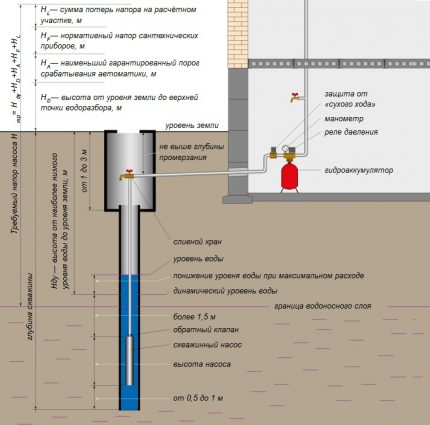
Which option is needed - superficial or deep?
The design specificity of water pumps is directly related to the depth of the equipped output.
According to the specified parameter, all types of units for water supply are divided into:
- Superficial. Are installed in the house or near a well. The surface type is used to transport water from a depth of not more than 7 - 9 m. They are used mainly in the summer to provide water for temporary housing, can be used to draw water from open sources and small wells.
- Submersible, otherwise deep or borehole. They are lowered directly into the mine by attaching to the feed hose and to the mounting cable. Submersible pumps supply water from a depth of 9 to 200 m. They are used mainly as the main working body of autonomous aquifer systems operating year-round.
Construction and installation of surface pumps significantly simpler than deep brothers. The suction capacity and efficiency are significantly lower, which leads to a relatively low price.
Submersible pumps are structurally more complex, much more expensive. They are equipped with multi-stage engines, thanks to which the pumps can extract water from great depths and at the same time create a noticeable pressure.

True, in the family of deep aggregates you can find representatives who work perfectly in “shallow” wells of 15-20 m each. Note that there will be no blockage or breakdown of the motor if the height of the water column is at least a meter between the bottom of the well and the submersible pump.
A similar distance should be between the top of the apparatus and the minimum water level in the well.
In the line of submersible units there are well and true models. Both options can be used for well equipment, but it is preferable to use a system with the corresponding name as a more adapted type.
Both are designed to pump water without pollution. For normal operation, they need a clean aquatic environment without grains of sand and clay suspension.
It is undesirable for deep-well equipment to be installed in an old well. In case of emergency, the walls and bottom of the excavation must be strengthened by first pumping water. Cracks and potholes must be repaired with concrete mortar and a new bottom filter should be installed.
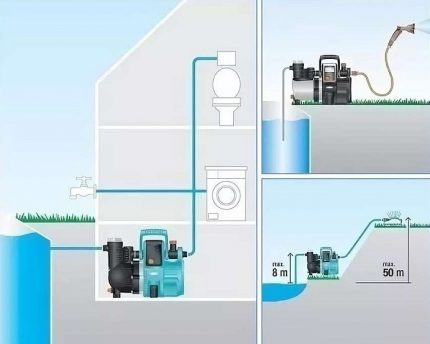
Surface systems are less sensitive to contamination. If a hole has been opened by a well intended for technical purposes, the choice should be stopped at one of the surface pumps.
For workings with an unstable water supply, there are models with a signal float that automatically stops pumping when the level falls below the technical limit.
Surface pumps can be used to extract water from wells up to 30 m deep if equip with ejector. The device is lowered into the mine by the type of a submersible unit, but water is pumped directly by the surface system.
However, with increasing depth, the performance of such a tandem decreases, and energy consumption increases. The acquisition of the indicated pair for deep production is considered unprofitable. Better to buy pumping stationequipped with a storage tank and automation.
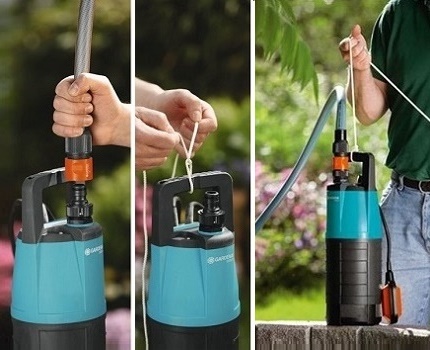
Necessary and sufficient characteristics of the unit
The technical passport of the unit will acquaint the future owner with the most useful information necessary in selecting the best pump model for a well.
The following characteristics should be considered:
- Maximum performance. Indicates the number of liters delivered per unit per minute. Depends on the power of the machine and the capacity of the pipe transporting the water. It is necessary for comparison with the real need for water.
- Suction depth. Indicated in meters, indicates how deep the pump can pump and transport water. It is necessary for comparison with the dynamic level and the specific depth of the well.
- The maximum pressure.Defines the distance between the water intake point and the highest water sampling point. It is necessary for comparison with the required hydraulic pressure calculated for specific conditions.
The main characteristic of the pump is performance. It should be equal to the flow rate of the points operated simultaneously or the amount of water consumed in one hour.
It is unreasonable to buy a pump unit with excess power. If the equipment will constantly switch to "dry run", the service life will be significantly reduced. On the other hand, an illiterate selection of the pump will result in a lack of pressure and a lack of water.
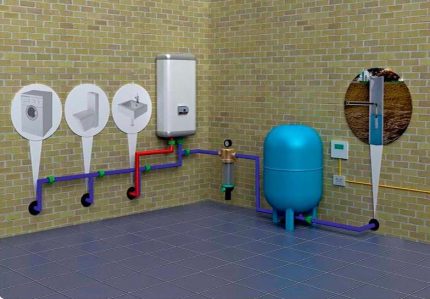
Another very important parameter, the flow rate of a well, influences the choice of a pump model for productivity.The amount of water in mine workings buried in a sandy aquifer is most often unstable.
Therefore, the performance of the unit and the frequency of its work are strongly recommended to coordinate with the flow rate of the well, and then focus on water flow.
An example of calculations for the selection of equipment
Suppose we buy a submersible pump for a well with a depth of 25 m. The dynamic level, measured after pumping, is set at a depth of 15 m. The distance to the house is 30 m.
Water points are located in the first and second floor of the cottage. Conditional consumers will be: shower, kitchen and watering tap. The toilet and wash basin as a means of periodic use are neglected.
Calculate the pressure. To do this, we summarize the value of the dynamic level of 15 m, the horizontal section of the water supply system, 30 m of which is equal to 3 m of vertical supply (30/10 = 3). We add to them a gravitational index of 5 m, consisting of 1 m for delivery to the first floor and 4 m for delivery to the second.
Add 30 m required for the normal functionality of any pumping system. The following expression turned out: 15 + 3 + 5 + 30 = 53 m or else 5.3 Atm is the necessary minimum for supplying water to the cottage. It is customary to select a performance technique with a small margin, taking into account some loss of power during the wear process.
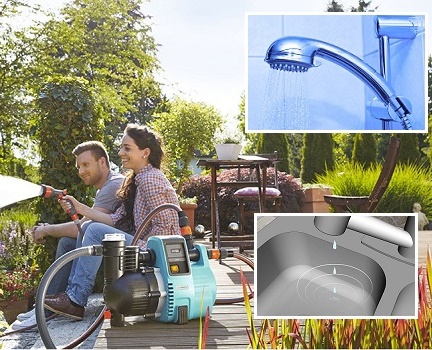
Calculate water consumption. We have three permanent water points. A watering tap spends up to 18 l per minute, a mixer in the kitchen 10 l, a shower 12 l per minute. It turns out 40 liters, to which we add 5 liters for plumbing, periodically consuming water.
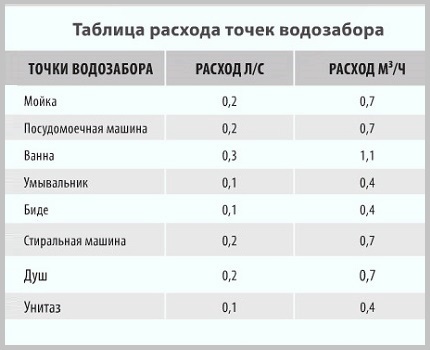
Consider that the flow rate should be less than the well flow rate by about 15%. If the dynamic level drops as a result of pumping water, the pump will switch to a “dry run”, which ultimately leads to accelerated wear of the equipment.
Choose a pump. Compare the performance data of the selected model with water flow and well flow rate. If it is not intended to include a storage tank in the water supply system, the pump must supply water in the volume of the total second flow rate.
In the presence of a conventional storage tank or accumulator you need to focus on the hourly flow of water.
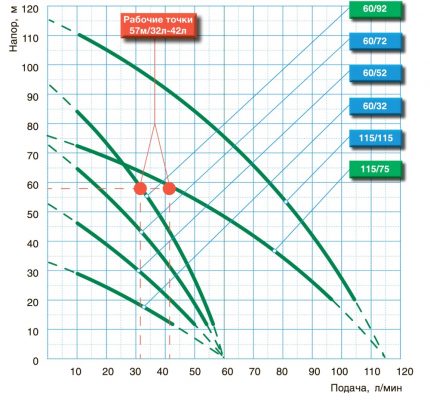
Differences in pump principle
The work of all types of water pumps is to suck in water, followed by pushing it into the water intake pipe and then through the pipeline. A vacuum is created inside the unit, due to which suction takes place.
The portion of water pumped into the vacuum chamber is displaced by the next portion. This continues until the desired liquid enters the tap intended for its passage.
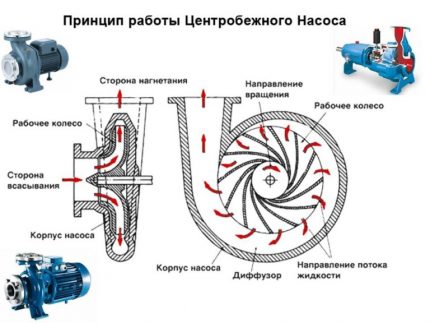
According to the methods of vacuum formation, household pumping equipment is divided into the following types:
- Centrifugal. They work due to the formation of centrifugal force by centrifugal impeller blades. These include a solid part of surface aggregates. It is the least sensitive to the presence of grains of sand in the water centrifugal pumpsbut there are still restrictions on the degree of pollution.
- Whirlwind. Create a vacuum by rotating the vortex wheel.This is a disk with small blades placed around the circumference, forming a vortex cavity inside the device. Particles of water that get into it are given additional acceleration due to which vortex aggregates give a pressure of a greater value than centrifugal ones. The disadvantage of vortex devices is their vulnerability to dirty water.
- Electromagnetic, otherwise vibrating. They function by drawing in water located inside the diaphragm, which in turn is driven by the reciprocating motion of the electromagnetic field. Relate to submersible pumps, in contrast to vortex counterparts are more adapted to somewhat contaminated water.
Self-priming pumps were invented to extract and transport water with a significant air content. These are surface systems, in the model range of which you can find options with and without an ejector. Various companies produce self-priming pumping equipment for pumping clean or contaminated water.
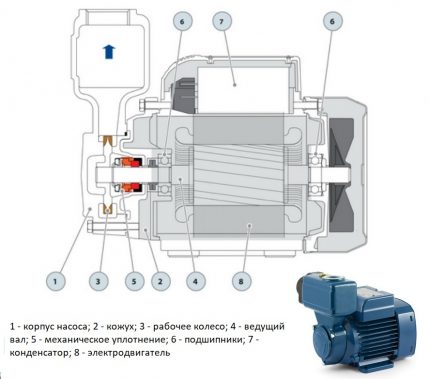
All of these types of pumps are used in the construction of autonomous water supply systems, supply water for household needs, drinking purposes and irrigation of the site.
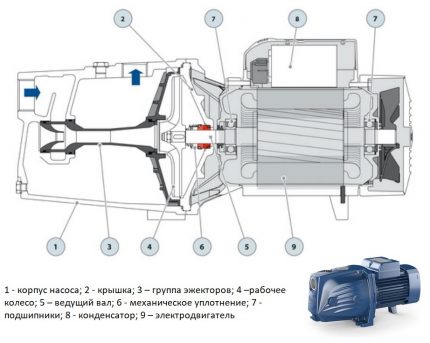
Overview of pumps from trusted manufacturers
An extensive range of reliable pumping equipment supplied by domestic and foreign manufacturing companies is offered to the buyer who owns the manor with a well.
Decent offers of foreign brands
We list the popular foreign brands of pumps that are in demand among summer residents and lovers of country life:
- ESPA, Spain. The products of the Espa Group manufacturer are characterized by stable operation, endurance, and are pleased with their maximum adaptability to operation in difficult Russian conditions. The company started with the release of centrifugal pumping systems more than half a century ago. Now for domestic use, the company offers a series of submersible well pumps and surface stations. Price tag from 9 thousand rubles.
- PEDROLLO, Italy. For more than 20 years, it has been supplying well pumps of the deep category and self-priming surface units to the domestic market. The company's products attract with its lightness, which successfully combines with the durability of parts and the casing; anti-corrosion materials that meet high environmental requirements are used in the production. Price from 14 thousand rubles.
- KARCHER or abbreviated KG, Germany. It has been producing pumps for more than 80 years, the product line for pumping equipment for wells includes submersible pumps and water supply stations with automatic equipment and a hydraulic tank. KG pump technology is characterized by perfect assembly accuracy and long service life. Price from 9 thousand rubles.
- GARDENA, Germany. The company specializes in the production of garden tools and equipment. It produces garden pumps for water intake from shallow openings and open reservoirs, downhole pumping equipment and automatic pressure stations. The price of units depends on constructive complexity, it starts from 6 thousand rubles, the average price tag of 13 - 23 thousand rubles.
- GRUNDFOS, Denmark. The largest manufacturer of pumping equipment, whose products are respected for their durability and a high degree of corrosion protection. Submersible and surface Danish pumping machines are reasonably popular, the average price of 27 thousand rubles.
- ZDS, Italy. It produces premium pumping equipment, the company is famous for its unique system of protecting engines from overheating, "dry running", power surges.In the product line for wells, there are positions with high productivity, capable of pumping water with some sand content. The average price tag is from 32 thousand rubles.
A wide foreign choice is somewhat overshadowed by the impressive cost for serious models. Moreover, pumps for the fence of the water can be purchased at a very reasonable price.
We will add to the serious disadvantages the high cost of repairs and the difficulty of delivering original spare parts to replace worn out and unable to withstand the hardships of local operation.
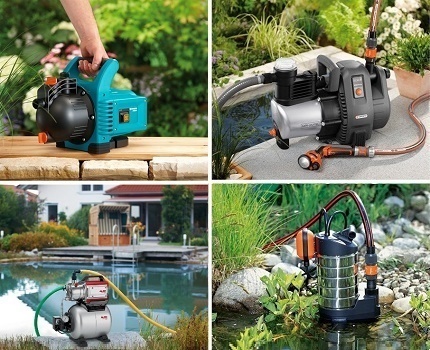
Details on domestic pumps
Cons of foreign units spontaneously turn into the advantages of domestic products. The buyer of a pump with a Russian brand will not be scared by the price, the difficulties of repair will not be a burden. A convincing one-year warranty, as well as the ability to quickly exchange an acquisition for a more suitable model, will be a nice bonus.
Kid: small but good!
With industriousness and unpretentiousness domestic pump kid many generations of summer residents are familiar. The products are manufactured by HMS Livhydromash OJSC located in the Vladimir region. For more than 70 years of development, the only representative has given rise to the appearance of numerous modifications.
In the product line there are models with variations in pressure and intake depth, there are options with a nozzle for the suction pipe located below or above.
With the lower nozzle they are acquired if they need to transport perfectly clean water. With the upper pipe they buy if there is a risk of clogging with silt and other suspended impurities.

The universal unit is suitable for extracting water from wells, open reservoirs, and wells. To equip a constantly functioning water supply system, this is not the most suitable type.
However, among equally compact machines, he leads in terms of performance. It is steady against power surges, loyal to shortcomings of work of the power supply network, is protected from "the dry course".
The Kid vibration unit attracts with its simple design and attractive price. On average, the cost of miniature equipment ranges from 1.5 to a little more than 2 thousand rubles. The analogue is pump trickle, practically no different from the Kid in technical and price aspects.

Well pumps from the company Gileks
Jeelex - A pioneer in the manufacture of pumps in the post-Soviet space. The company founded in Klimovsk near Moscow has been producing domestic and industrial discharge pumps for almost a quarter of a century. The manufacturer’s arsenal includes the latest equipment, innovative technologies and its own engineering developments.
Dzhileks offers the owners of suburban areas with a well a wide range of pumping equipment, issues installation and operation instructions. The company publishes recommendations on how to correctly select the optimal pump for a well and other sources of water supply.
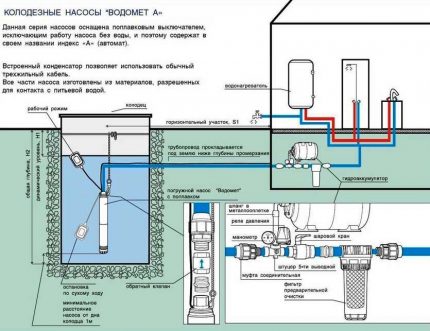
Self-priming, surface-mounted self-priming units are used to draw water from shallow wells Jumbo and automatic pumps.
The automatically functioning equipment delivers clean water from mine workings, trunk networks, open reservoirs, switches on / off independently, and maintains a stable pressure in the water supply system.
If the automatic station is equipped with an ejector, the purity requirements for the pumped water can be reduced. The price of the simplest products is from 6.5 thousand rubles.
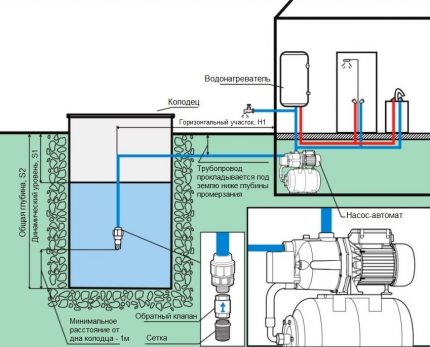
pump and automatic pump, the latter works in automatic mode, maintaining the necessary pressure in the system, turning on and off as necessary (+)
The marking of Jilex submersible pumps indicates the volume of maximum water flow and the pressure in the form of fractions.
Index A denotes automatic pumps, the operation of which is controlled by the level of water taken. The letter H denotes models with a frequency converter, the index DOM indicates automatic machines that maintain constant pressure in the water supply network. Price from 7 to 25 thousand rubles. depending on the design complexity.
Conclusions and useful video on the topic
Tips for selecting the best pumping equipment from specialists in the field of sales:
Personal experience of a summer resident who chose a pump for a deep well:
Overview of pumping equipment from the company Gileks to help customers:
The detailed information that we have proposed with the criteria for choosing the optimal well pump will help to acquire the ideal unit with the required technical characteristics.
We introduced the production leaders in the pump production segment, introduced the approximate price tags. Now you can confidently implement the planned purchase of the pump.
Looking for an efficient well pump? Or have experience using such installations? Please leave comments on the article and share your impressions about the use of pumping equipment.

 DIY manual water pump: a review of the best homemade products
DIY manual water pump: a review of the best homemade products 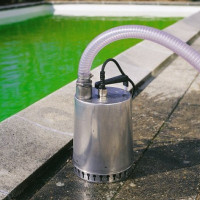 How to choose a pump for pumping dirty water: selection rules and an overview of the best models
How to choose a pump for pumping dirty water: selection rules and an overview of the best models  The best surface pumps: we choose pumping equipment for home and country communications
The best surface pumps: we choose pumping equipment for home and country communications 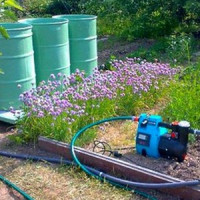 How to choose a good pump for watering the garden with water from a pond, barrel or pond
How to choose a good pump for watering the garden with water from a pond, barrel or pond 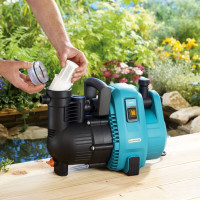 TOP-12 centrifugal pumps for a well: rating of the best + recommendations for choosing equipment
TOP-12 centrifugal pumps for a well: rating of the best + recommendations for choosing equipment 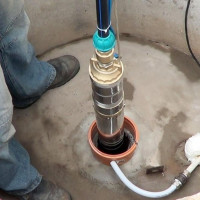 Submersible pumps for the well: 15 best models + tips for customers
Submersible pumps for the well: 15 best models + tips for customers  How much does it cost to connect gas to a private house: the price of organizing gas supply
How much does it cost to connect gas to a private house: the price of organizing gas supply  The best washing machines with dryer: model rating and customer tips
The best washing machines with dryer: model rating and customer tips  What is the color temperature of light and the nuances of choosing the temperature of the lamps to suit your needs
What is the color temperature of light and the nuances of choosing the temperature of the lamps to suit your needs  Replacement of a geyser in an apartment: replacement paperwork + basic norms and requirements
Replacement of a geyser in an apartment: replacement paperwork + basic norms and requirements
If you take a submersible pump, then choose between the production of pumps Livhydromash and Gileks, and from the western GRUNDFOS. All other pampering or overpayment of money for the brand. Brook and Kid from Liven are stable reliable, but outdated. If you need a pump with a selection of characteristics, take the “Dzhileks” from Klimovsk, they will plug in the belt all the listed Western companies in terms of price, reliability, quality, characteristics and capacity. Although GRUNDFOS is produced in China and Russia, it still has a high-quality assembly, and is also unpretentious in operation.
All the pumps that I have listed are maintainable, interchangeable, easy to operate and forgive users.
I completely agree with the opinion from the previous comment about the reliability of the pump “Kid”.The fact that he is out of date is not a reason to refuse him. These pumps have been operating for many years. From myself I wanted to share one useful “live hack”. To prevent the pump from clogging with sand and silt when using it in a well, pull a normal female stocking over it. It will act as a filter and the pump will not overload.
What a “Baby”! What do you advise !!! Any whirlwind, centrifugal, but not vibratory! All seams and water seals will fly! Please pump something from the pit, and only to kill the well into the well. Read the recommendations of drilling and well companies, they even do not recommend primary pumping there.